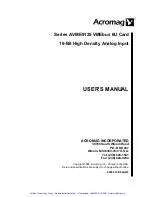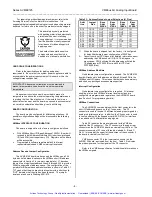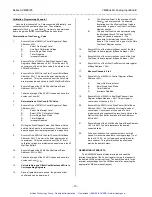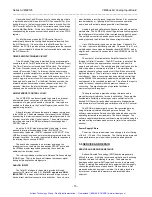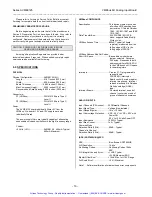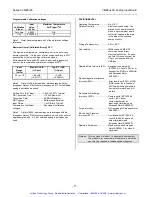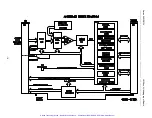
Series AVME9125 VMEbus 6U Analog Input Board
___________________________________________________________________________________________
- 3 -
•
±
10V A/D Range
- Bipolar
±
10V range is supported.
•
Individual Channel Mail Box -
A storage buffer register is
available for each of the 32 differential channels.
•
Programmable Control of Channel Scanning
- Scan all
channels or a subset of the channels to allow an overall
higher sample rate. Digitized channels include all sequential
channels beginning with a specified start-channel value and
ending with a specified end-channel value.
•
User Programmable Interval Timer
- Controls the delay
between each channel converted when Uniform-Continuous
or Single Scan modes are selected. If Burst-Continuous is
selected, the Interval Timer controls the delay after a group of
channels are converted before conversion is initiated on the
group again. Supports a minimum interval of 11.25
µ
sec and
a maximum interval of 2.09 seconds.
•
Uniform Continuous Scanning Mode
- All channels
selected for scanning are continually digitized in a round
robin fashion with the interval between conversions controlled
by the programmed interval timer. The results of each
conversion are stored in the channel’s corresponding mail
box buffer. Scanning is initiated by a software or external
trigger. Scanning is stopped by software control.
•
Burst Continuous Scanning Mode
- All selected input scan
channels are sequentially digitized at a
≅
67KHz conversion
rate (
≅
15
µ
second conversion time). At the end of a
programmed interval time a new conversion of all channels is
re-initiated. The conversion results are stored in each
channel’s mail box buffer. This mode can be used as a
pseudo-simultaneous sampling mode for low to medium
speed applications requiring simultaneous channel
acquisition. For example, if four channels are selected then
they could be pseudo-simultaneously converted every 60
µ
seconds (each of the channels actually takes
≅
15
µ
seconds). This is repeated in bursts determined by the
programmed interval time. The scan is initiated by a software
or external trigger. Scanning is stopped by software control.
•
Uniform Single Cycle Scan Mode
- All channels selected
for scanning are digitized once with the idle time between
each channel conversion controlled by the programmed
interval timer. The scan is initiated by a software or external
trigger.
•
Burst Single Cycle Scan Mode
- All channels selected for
scanning are digitized once at
≅
67KHz conversion rate
(
≅
15
µ
sec/Channel). The scan is initiated by a software or
external trigger.
•
Interrupt Upon Conversion Complete Mode
- May be
programmed to interrupt upon completion of conversion for
each individual channel or upon completion of conversion of
the group of all scanned channels.
•
Software Programmable Interrupt Level
- The VMEbus
interrupt level is software programmable. Additional registers
are associated with each interrupt request for control and
status monitoring.
•
New Data Register
- This register can be polled, to indicate
when new digitized data is available in the mail box. A set bit
indicates a new digitized data value is available in the bit’s
corresponding mail box register. Register bits are cleared
upon read of their corresponding mail box register or start of
a new scan cycle.
•
Missed Data Register
- A set bit in the Missed Data register
indicates that the last digitized value was not read by the host
computer quickly enough and has been overwritten by a new
conversion. The Missed Data register has a bit
corresponding to each of the 32 differential channels. Each
Missed Data register bit is cleared by a read of its
corresponding mail box data value or start of a new scan
cycle.
•
Fault Protected Input Channels
- Analog input overvoltage
protection from -35 V to +55 V is provided in the event of
power loss or power off.
•
±
15 Volt Power Supplies -
On board
±
15 volt power
supplies are provided to accommodate the
±
10 volt input
signal span.
•
Individually Filtered Power
- Fi5V, +15V, and -15V
DC power is provided to the card via passive filters present
on each supply line. This provides optimum filtering and
isolation between the system and the board and allows
analog signals to be accurately measured without signal
degradation from the system.
•
Base Address Jumpers -
The only hardware jumper settings
required on the board set the base address of the card in the
VMEbus short I/O space.
VMEbus INTERFACE FEATURES
•
Slave Module
-Board Register Short I/O Access A16,
D16/D08(O)
•
Supports Short I/O Address Modifiers
- Supports short I/O
(A16) address modifiers 29H, 2DH (H = Hex), only. The
board base address is set by hardware jumpers and decoded
on 256 byte boundaries.
•
Supports Read-Modify-Write Cycles
- The board supports
VMEbus read-modify-write cycles.
•
Interrupt Support
- I(1-7) interrupter D16/D08 (O). The
VMEbus interrupt level is software programmable. The
board’s software programmable registers are utilized as
interrupt request control and status monitors. Interrupt
release mechanism is Release On Register Access (RORA)
type.
2.0 PREPARATION FOR USE
UNPACKING AND INSPECTION
Upon receipt of this product, inspect the shipping carton for
evidence of mishandling during transit. If the shipping carton is
badly damaged or water stained, request that the carrier's agent
be present when the carton is opened. If the carrier's agent is
absent when the carton is opened and the contents of the carton
are damaged, keep the carton and packing material for the agent's
inspection.
Artisan Technology Group - Quality Instrumentation ... Guaranteed | (888) 88-SOURCE | www.artisantg.com


